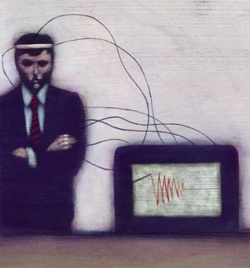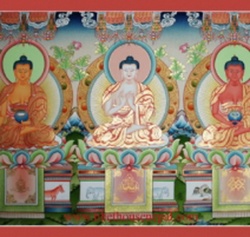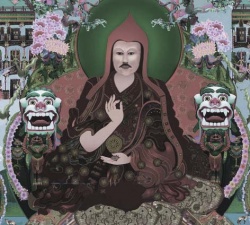Jnanagarbha's Commentary on Just the Maitreya Chapter from the Samdhinirmocanasutra
Jnanagarbha's Commentary on Just the Maitreya Chapter from the Samdhinirmocanasutra: Study, Translation, and Tibetan Text. By JOHN POWERS. New Delhi: INDIAN COUNCIL OF PHILOSOPHICAL RESEARCH, 1998. Pp. xii + 156.
Over roughly the last fifteen years, John Powers has devoted a significant part of his scholarly attention to translating and analyzing the contents of the Samdhinirmocanasutra. The chief results of this work so far have been his doctoral dissertation, "The Concept of the Ultimate (Don Dam Pa, Paramartha) in the Samdhinirmocana-Sutra" (University of Virginia, 1991), a work on Hermeneutics and Tradition in the Samdhinirmocanasutra (Brill, 1993), another entitled Two Commentaries on the Samdhinirmocana-sutra (Edwin Mellen, 1992), a translation (with unedited Tibetan text) of the sutra itself (Wisdom of the Buddha (Dharma, 1995]), and a pair of journal articles on ancillary topics. The work under review is the latest installment in this oeuvre.
As the title makes clear, the subject of this book is the 'Phags-pa dgongs pa nges par 'grel pa'i mdo las 'phags pa byams pa'i le'u nyi tshe'i bshad pa (Arya-samdhinirmocana-sutra-aryamaitreyakevalaparivarta-bhasya), a work attributed to Jnanagarbha which can be found in Tibetan translation in the bsTan-'gyur, and which comments exclusively on the eighth chapter of the sutra, in which the chief interlocutor is Maitreya. Powers has undertaken to edit the Tibetan translation, translate the work into English, and explore its importance in an introductory study.
Turning first to the Tibetan text that Powers provides (pp. 73-143), one discovers an abundance of problems. While at one point he refers to the text provided as a "critical edition" (p. 10), nowhere does he address the principles by which his editing is guided. This would seem to be especially called for in an edition of a translation. In addition to this methodological unclarity, few exemplars seem to have been haphazard--consisting only of the two facsimile editions most readily available in Western libraries (i.e., the Otani University Peking and the University of Tokyo sDe-dge).
There are, furthermore, many errors in the text presented--several of them quite elementary. At the beginning, for instance--in the very title of the work (p. 75)--one reads 'phags pa byams pa'i le'u'i bshad pa bshugs so. The correct reading is, of course,bzhugs so. Such an error (presumably a typo) can be put down to nothing but extreme carelessness on the part of the author and the publisher. In addition, there are several tsheg-s missing throughout the text. Some of these have semantic relevance: for example, on page 96 (line 5), one reads las for la sa. Other textual errors appear elsewhere, such as snar instead of sngar (p. 80, line 8).
The apparatus, furthermore, contains readings that are not particularly relevant. For instance, it notes variant readings such as gnyis ga'i for gnyis ka'i and gyi for kyi (after a sa yang 'jug). These are mere orthographical idiosyncrasies and might have been appropriately mentioned in the introduction, but serve no real purpose in the textual apparatus.
Powers has also taken the liberty of breaking up the text into modern-style paragraphs, presumably for the ease of the contemporary reader. While I have no principled objection to this practice, it should be clear that an editor needs to exercise due care when he begins to restructure (or, rather, add structure to) the work he is editing. In this case, such care is apparently lacking. For example, the clause 'du she sna tshogs rnam par spangs te is parsed as the end of a paragraph, both in the Tibetan text (p. 95) and the English translation (p. 26), even though the particle te clearly shows that this clause is to be construed with what follows. If Powers wishes to emend this conjecturally, he needs to give his justification--a difficult task given that this clause fits naturally with the succeeding passage, which explains how one gains a joy free of various discrimination's ('du shes sna tshogs dang bral ba), rather than the preceding, which explains the elimination of gnas ngan len, not 'du shes. The result is an unnatural break in the Tibetan text and a misleading English translation.
Turning now to the introductory material, the so-called "study," which bears the ambitious title "The Samdhinirmocana-sutra and Its Commentaries," consists of a mere seven pages of discussion regarding "the author" and a further two pages concerning the "translation and Tibetan text." The former addresses chiefly the question of how and to what degree Jnanagarbha fits into the doxographical categories of later Tibetan writers. That is, is Jnanagarbha best considered a "Sautrantika-Madhyamika," a "Yogacara-Madhyamika," a "Svatantrika-Madhyamika," or a "Sautrantika-Svatantrika-Madhyamika"? This type of discussion--while perhaps relevant to the second-order issue of understanding how the Tibetan doxographical tradition sought to understand Jnanagarbha's place within its overall (generally ahistorical) model of the development of Buddhist thought--does little to illuminate Jnanagarbha's place within a more sophisticated historical framework of understanding (such as one hopes to obtain through modern scholarly methods). It is clear that these categories, like the analogous Western rubrics "Enlightenment," "Romantic," "Positivist," etc., are merely pedagogical shortcuts (meant primarily for beginning students) and do not adequately reflect the subtleties of any author's thought.
In the latter two pages of the "study," Powers seeks to defend the exceedingly literal approach to translation he advocates by contrasting his method (which he calls "translation") with one that lays more weight on producing a coherent, meaningful product in the target language (which he calls "paraphrase"). His perspective on these important issues of translation is unsubtle at best. For one, it misses completely the fact that there is a continuum of possible approaches (from the over-literal to the wildly imaginative rendering). Having thus artificially limited the possibilities, Powers advocates the more "literal," if less "palatable," "translation" (p. 11)--which seems to entail the type of text known to students of classics as a "pony"--useful only as a crutch for those who already know Tibetan and could thus read the text for themselves. Otherwise, one naturally assumes that any translation (outside of a textbook example) will involve some degree of accommodation to the target language, and thus will be in some sense a "paraphrase." A responsible translator does not, for example, translate the clause rgyal pos dgra bo rnams bcom mo as "[the] king-by enemy-s destroyed," nor even (as M. Hahn suggests as a "more exact" rendering in his textbook) "by the king (as agent) an enemies-destruction happened," but rather as the fluent English sentence "the king destroyed [his] enemies." (1) Given what we will see below, one suspects that this "principled stance" concerning translation is some sort of prophylactic defense for having published the first draft of a translation--rendering the words without due regard for their sense and context.
As one would expect from such a problematical approach to translation, Powers himself does not even wholly adhere to his declared method. There are several places where his rendering does not adhere to a strict rule of correspondence. For instance, dngos po appears as "thing" (p. 14), yet shortly thereafter becomes "phenomenon" (p. 15). Further (and setting aside the problems with both renderings), the phrase rtogs pa'i gnas skabs is rendered "at the level of realization" and "at the level of understanding" on the same page (p. 16) within eleven lines of each other. At other places, the meanings of words are actually reversed. For instance, Powers translates the clause [[grangs med pa zhes bya ba ni dpag tu med pa de nyid kyi[phyir te]], by "[they] are 'measureless' because of their innumerability." This should have been rendered "[they] are 'innumerable' (grangs med pa) because of their measurelessness (dpag tu med pa de nyid kyis)." In the next clause. Powers more appropriately translates grangs as "enumeration."
As one can already intimate from the above--and quite aside from problems with the theoretical approach--the English translation is full of fundamental errors. There are so many, in fact, that it would not be practical or valuable to catalogue them all.
Some are minor: for instance "now" (da) is missing from the translation on p. 15. Elsewhere, however, grammatical particles are simply ignored or misunderstood. For instance, on p. 93 of the Tibetan text, there is a passage that reads: [[gnas gyur pa la gzhol ba zhes bya ba la sogs pa la gnas ni sangs rgyas kyi[chos rnams kyi ste/ sa dang pha rol tu phyin pa'i stobs so]]/. Powers translates this as follows (p. 24): "In [the phrase,] 'flow into transformation of the basis' (gnas gyur, asrayaparavrtti), basis [refers to] the qualities of a buddha; (transformation occurs] through the power of the [ten] levels (sa, bhumi) and the [ten] perfections (pha rol tu phyin pa, paramita)." It seems clear that the particle ste here serves to indicate equivalent phrases. The central idea is that the "basis" (gnas) is the "power" (stobs). The other two phrases are both in the genitive, modifying stobs; thus: "the 'basis' is the power of the qualities of a buddha, i.e., of the stages (sa, bhumi) and perfections." Not only is Powers' translation forced and fanciful, it misconstrues the basic grammatical structure of the proposition.
Though Powers avoids some of the more problematical translations one commonly finds (such as "ground" for sa, in the context of byang chub sems dpa'i sa), there are nonetheless other places where his choice of terminology is wanting. On p. 26, he translates the term rnam pa thams cad mkhyen pa (presumably sarvakarajnatva) as "an exalted knowledge of all aspects." This example nicely illustrates the problems often found in works written by scholars with inadequate knowledge of Sanskrit, addressing Indian texts through their Tibetan translations. First, one sees the typical mechanical translation of rnam pa (akara, "form, shape, figure, aspect, appearance, expression, sign, identity") (2) as "aspect." Even more troubling, however, is the translation of mkhyen pa as "exalted knowledge." One assumes that, in "exalting" this "knowledge," Powers has sought to render the impact of the honorific language (zhe sa) in which the Tibetan translators have couched the Sanskrit term (i.e., mkhyen pa, rather than shes pa). Given that the Sanskrit in which Jnanagarbha expressed himself has no such honorific register, such "over-translation" of the Tibetan is unwarranted.
Aside from the pervasive problems of the text and translation, there are further deficiencies apparent in the composition of the book as a whole. The index, notably, is rather haphazard. Although Etienne Lamotte and Katsumi Mimaki are referenced, there is no entry for Geshe Yeshe Thabkhe. Given that this noted Tibetan scholar apparently spent "an enormous amount of time" (p. xi) reading through the text closely with Powers, and that Powers relies on and cites his expertise on nearly every page of the notes, this omission is very strange indeed.
The bibliography is also marred by problems. At least one entry lacks information on the publisher. There also seems to be some confusion between "texts" and "works." While Powers cites "Indian texts" and "Tibetan texts," he lists "Works on Buddhism by Contemporary Scholars." Presumably, he is interested in more than merely the physical artifacts (i.e., "texts") he lists under the former two categories, but also in their contents (i.e., the "works" of which they are exemplars). (3) Further, under "Indian texts," he cites chiefly Tibetan translations of Indian works (with, however, the occasional Sanskrit edition and/or translation into a European language). "Indic works" may have been a more suitable rubric. (4)
Two entries in the bibliography seem irreconcilable with each other: to wit, "Takakusu, Junjiro. 'The Date of Vasubandhu.' Indian Studies in Honor of Charles Lanman. Cambridge, MA: 1929, pp. 78-83" (p. 151) and "Takasaki, Jikidoo. 'The Date of Vasubandhu the Great Buddhist Philosopher.' Indian Studies in Honor of Charles Lanman. Cambridge, MA: 1929, pp. 79-88" (p. 152). An article penned by Junjiro Takakusu does appear in the cited work, bearing the title "The Date of Vasubandhu, the Great Buddhist Philosopher" (pp. 79-88), but the byline reads neither Jikidoo Takasaki nor Junjiro Takakusu, but rather "Jyan Takakusu." In another lapse, the name of the author, Noel Peri appears as Noel Peri.
I would not belabor such seemingly minor points of bibliographic propriety were it not for the fact that these discrepancies actually occur verbatim in the bibliography of Powers' Hermeneutics and Tradition in the Samdhinirmocanasutra, suggesting that this bibliography was taken over nearly wholesale from his earlier book, without revision. (I have not been able to check these bibliographies against that found in his dissertation.) In fact, neither "Jikidoo Takasaki" nor "Junjiro Takakusu"--nor their works or ideas--are either referred to or made use of in the book under review.
In short, this work is of extremely poor quality in every respect: philological, philosophical, translational--even bibliographical. The methods upon which it is based are unsound, the execution is careless or incompetent, and the results are consequently unreliable. Readers will be well advised to look elsewhere for scholarship in this area.
1. Cf. Michael Hahn, Lehrbuch der Klassischen Tibetischen Schriftsprache (Bonn: Michael Hahn, 1981), 53; "'Der Konig vernichtete (seine) Feinde.' Genaur: 'Durch den Konig (als Agens) fand ein Die-Feinde-Vernichten statt.'"
2. See, e.g., Vaman Shivaram Apte. The Practical Sanskrit-English Dictionary, rev. ed. (Delhi: Motilal Banarsidass, 1998), 307.
3. I should observe, in Powers' defense, that this confusion between "texts" and "works" is widespread in Indological and Tibetological literature.
4. Interestingly, in Powers' previously published Hermeneutics and Tradition in the Samdhinirmocanasutra, the first two sections were more appropriately entitled "works by Indian authors" and "works by Tibetan authors": an editorial change initiated by Brill?
christian k. wedemeyer
university of chicago





